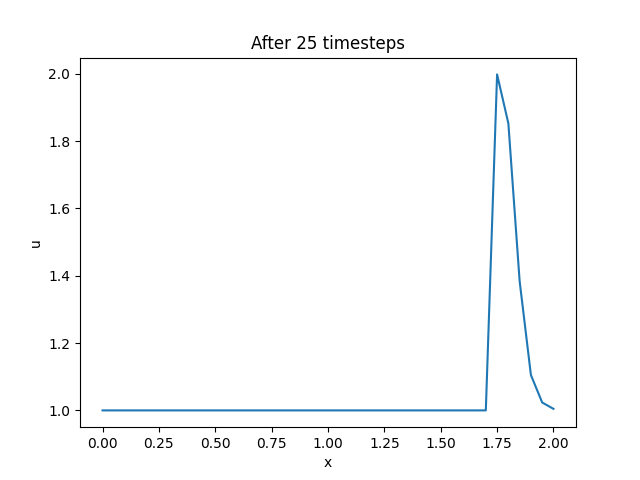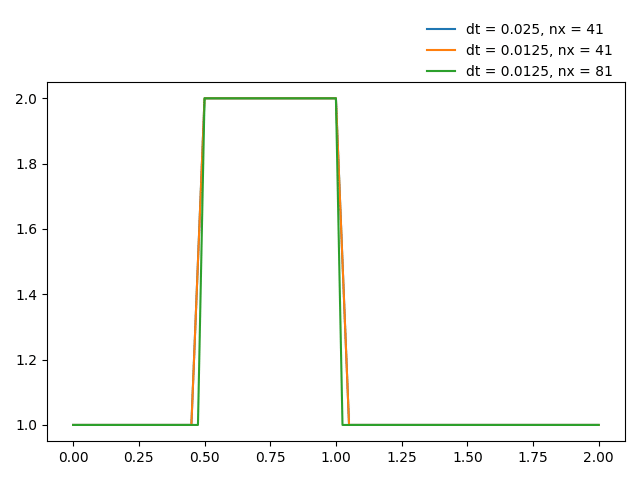现在我们使用CFD_Python_01中同样的方法,实现一维非线性对流问题的求解。
一维非线性对流方程为:
\[ \frac{\partial u}{\partial t} + u \frac{\partial u}{\partial x} = 0 \]
在方程的第二项,我们不再乘以常数 \(c\) ,而是乘以方程的解 \(u\) 。因此,这个方程的第二项现在是非线性的。
我们使用 CFD_Python_01 中同样的方法,即:时间项向前差分、空间项向后差分。离散方程为:
\[ \frac{u_i^{\tau + 1} - u_i^{\tau}}{\Delta t} + u_i^{\tau} \frac{u_i^{\tau} - u_{i-1}^{\tau}}{\Delta x} = 0 \]
求解得到方程唯一的未知项 \(u_i^{\tau + 1}\) :
\[ u_i^{\tau + 1} = u_i^{\tau} - \frac{\Delta t}{\Delta x} u_i^{\tau} (u_i^{\tau} - u_{i-1}^{\tau}) \]
Python 实现
与之前一样,我们先导入需要的库,然后申明离散空间和时间所需的变量。接着创建数组 \(u\) ,令其在 \(0.5 \leq x \leq 1\) 时为 \(2\) ,其余范围为 \(1\) 。
1 | import numpy as np |
执行完成后,效果如下图所示。 
修改代码,将数据存储到一个二维数组中,并绘制动画: 1
2
3
4
5
6
7
8
9
10
11
12
13
14
15
16
17
18
19
20
21
22
23
24
25
26
27
28
29
30
31
32import numpy as np
import matplotlib.pyplot as plt
from matplotlib.animation import FuncAnimation
nx = 41
dx = 2 / (nx - 1)
nt = 25
dt = .025
u = np.ones((nt, nx))
u[0, int(.5 / dx):int(1 / dx + 1)] = 2
for n in range(1, nt):
for i in range(1, nx):
u[n, i] = u[n - 1, i] - u[n - 1, i] * dt / dx * (u[n - 1, i] - u[n - 1, i - 1])
fig = plt.figure()
ax = fig.add_subplot(111)
line, = ax.plot(np.linspace(0, 2, nx), u[0, :])
ax.set_xlabel('x')
ax.set_ylabel('u')
ax.set_title('1D Nonlinear Convection')
def update(frame):
line.set_ydata(u[frame, :])
return line
ani = FuncAnimation(fig, update, frames=nt, interval=100)
ani.save('wave1.gif', fps=10)
plt.show()
效果如下图所示。

修改代码,设置不同的网格尺寸和时间步长,并绘制动画。由于时间步长不同,所以数组的行数有差异,为了完成动画的绘制,对时间步长较大(行数较小)的数组的行进行复制。
1 | import numpy as np |
效果如下图所示。

可以看到,网格尺寸不变时,减小时间步长,有时候反而会使结果变得更不理想。在仿真计算时,有必要使用不同的网格尺寸、不同的时间步长,以便找到最合适的配置。